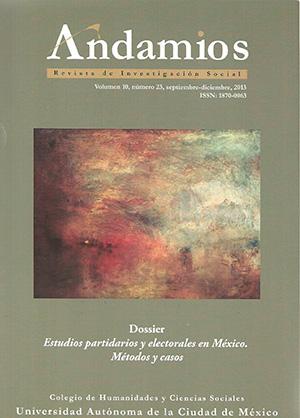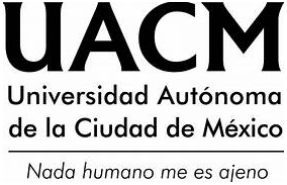Mexican System Nationalization Supporter
DOI:
https://doi.org/10.29092/uacm.v10i23.249Keywords:
Nationalization, Cleavages, Party Systems, Political Behavior, Presidential ElectionsAbstract
The paper aims to present levels of nationalization that has acquired the Mexican party system since the presidential election of 1994 to the latest 2012. To this end, use indexes of variation and dispersion in order to analyze the vote of the main political forces. It is argued that the different geographical constituencies have become increasingly homogeneous in terms of electoral political behavior, as there is a tendency of political parties, particularly the opposition to the PRI, to improve performance in the different regions of the country.
Downloads
References
Alemán, E. y Kellam, M. (2008), “The Nationalization of Electoral Change in the Americas”, en Electoral Studies, 27, p. 193-212.
Bartolini, S. y Mair, P. (1990), Identity, Competition and Electoral Availability. The Stabilization of European Electorates, 1885-1985, Cambridge: Cambridge University Press.
Bochsler, D. (2010), “Measuring Party Nationalization: a New Gini-Based Indicator that Corrects for the Number of Units”, en Electoral Studies, p. 29, 155-168.
Caramani, D. (2004), The Nationalization of Politics. The Formation of National Electorates and Party Systems in Western Europe, Nueva York: Cambridge University Press.
Cheresky, I. (2007), “Los desafíos democráticos en América Latina en los albores del siglo XXI”, en I. Cheresky (comp.), Elecciones presidenciales y giro político en América Latina, Buenos Aires: Manantial.
Chhibber, P. y Kollman, K. (2004), The Formation of National Party Systems, Princeton: Princeton University Press.
Claggett, W., Flanigan, W. y Zingale, N. (1984), “Nationalization of the American Electorate”, en The American Political Science Review, 78, p. 77-91.
Cox, G. W. (2004), La coordinación estratégica de los sistemas electorales en el mundo, Barcelona: Gedisa.
Instituto Federal Electoral (2008), Código Federal de Instituciones y Procedimientos Electorales, México: Dirección Ejecutiva de Organización Electoral.
——— Estadística de las elecciones federales de 1994, México: Dirección Ejecutiva de Organización Electoral.
——— Sistema de consulta de la estadística de las elecciones federales de 2000, México: Dirección Ejecutiva de Organización Electoral.
——— Estadísticas de las elecciones federales de México 2006, México: Dirección Ejecutiva de Organización Electoral.
——— Resultado del cómputo distrital de la elección de presidente de losEstados Unidos Mexicanos de 2012, por entidad federativa, México: Dirección Ejecutiva de Organización Electoral.
Kasuya Y. y Moenius, J. (2008), “The Nationalization of Party Systems: Conceptual Issues and Alternative District-Focused Measured”, en Electoral Studies, 27, p. 126-135.
Lago, I. y Montero, J. R. (2010), “La nacionalización del sistema de partidos en España: una perspectiva comparada”, en José Ramón Montero e Igancio Lago (eds.), Elecciones generales 2008, Madrid: Centro de Investigaciones Sociológicas.
Laakso, M. y Taagepera, R. (1979), “Effective Number of Parties: A Measure with Application to West Europe”, en Comparative Political Studies, 12, p. 3-27
Mainwaring, S. y Jones, M. (2003), “La nacionalización de los partidos y los sistemas de partidos: una medición empírica y su aplicación en el continente americano”, en Política y Gobierno, vol. X, núm. 1, primer semestre.
Mair, P. (2006), “Cleavages”, en Richard Katz y William Crotty, Handbook of Party Politics, Londres: Sage Publications Ltd.
Rokkan, S. (1970), Citizen, Elections, Parties. Approaches to the Comparative Study of the Processes of Development, Nueva York: David McKay Company.
Schattschneider, E. (1960), The Semisovereign People: A Realist’s View of Democracy in America, Nueva York: Holt, Rinehart and Winston.
Published
Issue
Section
License
This Journal is licensed under Creative Commons Mexico 2.5. It is allowed to reproduce and disseminate the contents of the Journal for educational or research purposes, not for profit, as long as they are not mutilated and cite the source (Andamios, Revista de Investigación Social) and the author.
The copyright of the articles published in Andamios, Revista de Investigación Social are transferred by the author(s) to Universidad Autónoma de la Ciudad de México when the originals have been accepted, so that they are published and distributed both in the printed and electronic versions of the Journal. However, as established by law, the author(s) retains their moral rights. The author(s) will receive a form of assignment of copyright that they must to sign when their original has been accepted. In the case of collective articles, the signature of one of the authors will suffice, provided that the latter has obtained the consent of the others.
Authors may use the material of their article in other works or books published by themselves, with the condition of quoting Andamios as the original source of the texts.
The articles contained in this publication are the responsibility of their authors and do not compromise the official position of Andamios, Revista de Investigación Social of the Universidad Autónoma de la Ciudad de México.


